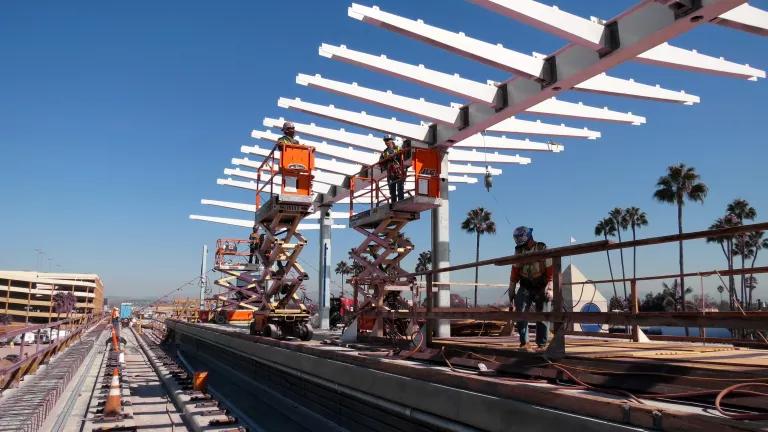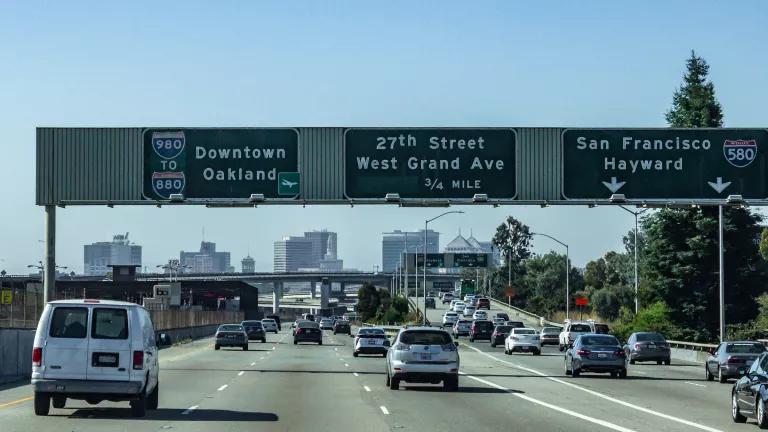The Transition to Clean Cars Just Got Accelerated—Big Time
After an unanimous vote of approval by the state’s Air Resources Board, California cemented its commitment towards the transition to 100% zero-emission vehicles sales.

Testifying in Support of ACCII
After an unanimous vote of approval by the state’s Air Resources Board, California cemented its commitment towards the transition to 100% zero-emission vehicles sales. The adoption of the Advanced Clean Cars II (ACCII) regulation means that by 2035, every new car and truck sold in California would be zero-emission—which includes battery electric, plug-in hybrids, and fuel cell electric vehicles. However, more needs to be done to advance equitable access to clean, zero-emission vehicles in communities historically overburdened with transportation pollution.
The Board approval of the ACCII regulation is an important win and step in the fight against climate change and helping to improve air quality in not only California, but in other states that can now choose to adopt these more stringent-than-federal standards. As we have previously blogged about, the Air Resources Board estimates that the ACCII regulation would provide over $14 billion in health benefits in California alone.
This is a commonsense standard that is designed to help to accelerate the transition to electric vehicles that is already occurring in the automotive industry and ensuring that the extensive zero-emission vehicle commitments that automaker have made are met. In fact, according to Atlas Public Policy vehicle manufacturers and battery companies have already announced over $86 billion towards electric vehicle and battery production domestically.

And vehicles are readily available for drivers as well—there are currently 65 available electric vehicle models that customers can purchase today, and these numbers are expected to increase. Another 55 new EV models are expected to arrive between now and the end of 2026, resulting in a plethora of consumer choices. The adoption of ACCII will help to accelerate this transition.
August was a busy month for electric vehicles, with the signing of the federal Climate Bill into law, which will further help to accelerate this transition to ZEVs and to ensure that automakers are able to meet the year-over-year sales requirements. And the bi-partisan infrastructure bill, along with additional funding support in California, will further help to ensure there is enough charging infrastructure to help support the additional influx of electric vehicles on the road.
But in the near-term, California’s current and expected funding levels could meet the state’s public, workplace, and shared multiunit dwelling charging needs over the next five years (including the beginning of the ACC II program). It will be critical though for the legislature to pass the governor’s ZEV investment proposal; the federal funds under the bi-partisan infrastructure bill are disbursed as expected; and the state’s Public Utilities Commission approves supportive utility filings. If California continues those investment trends, it will be on a path to meet the state’s EV and infrastructure goals for 2030 and beyond, but California must also continue to do even more to support equitable access to the infrastructure and EVs.
Continuing the Fight to Provide Equitable Access to Clean Transportation
Despite the tremendous climate, health, economic, and air quality benefits ACCII will bring to California and other states that choose to adopt the standards, the program and California’s policies do not go far enough to help disadvantaged communities that are often historically overburdened with transportation pollution. The program adopted today includes additional equity measures—in the form of “zero-emission vehicle credits” used to show compliance—that will provide automakers with incentives to increase access to clean, zero-emission vehicles in disadvantaged communities. However, there is no certainty that automakers will participate and that these communities will reap the benefits of zero-emission vehicles.
Therefore, it is imperative that ARB—and similar entities in other states—work directly with equity partners and automakers to develop complementary policies to increase access to zero-emission vehicles in disadvantaged communities.
At the Board Hearing, the Board adopted a Resolution directing its staff to evaluate the equity measures periodically as well as “implement strategies, including incentives, transportation-system-based, and regulatory strategies, to further expand low-income and disadvantaged communities’ access to ZEVs and zero-emission mobility.”
This is a good step forward, and California and other states will need to consider additional policies and programs to ensure equitable access to zero-emission vehicles. Voters in California will have an opportunity in November as well to help support additional funding for these types of programs through Prop 30. The initiative would tax the super-wealthy, raising $100 billion in long-term funding to assist households such as low-income and disadvantaged community members and truck and bus fleets to transition to zero-emission vehicles and needed infrastructure, increase access to other clean mobility options, and support programs that fight and prevent wildfires.
ARB also has the opportunity to strengthen the Advanced Clean Fleets rule—a truck purchase requirement for certain types of public and private fleets that’s currently under development. A stronger Advanced Clean Fleets rule could dramatically clean up toxic air pollution in freight-impacted that are predominantly low-income and communities of color.

Photo by Red Dot on Unsplash
Getting Other States to Adopt Clean Cars
Seventeen additional states adopted and implemented all or a portion of California’s prior version of the standards—Advanced Clean Cars I—following a waiver approval from the US Environmental Protection Agency. These states, together with California, represent 40% of the U.S. passenger vehicle market. And now, eligible states will yet again have the opportunity to adopt California’s newest program to put themselves in the front of the line for the array of EV models and their benefits.
Four states—Washington, Oregon, Vermont, and Massachusetts—have already officially announced their plans to adopt ACCII by the end of 2022, with several others indicating plans for adoption in 2023. This means that residents in these states will be able to reap the benefits—including lower fueling and maintenance costs, and improved air quality and health—of a transition to zero-emission vehicles. But as with California, it will be up to these states to also ensure there are complementary policies in place, including programs that center equity and provide benefits to disadvantaged communities in these states.
The adoption of ACCII is a huge step forward in the transition to clean vehicles and cements California's global clean transportation leadership—and now we must continue this momentum in California and other states so that all residents can realize the benefits of this transition to a zero-emission vehicle future.





